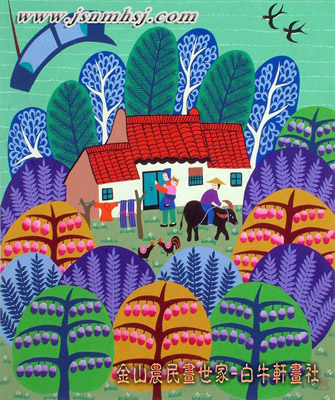 |
|
Jinshan Farmer Painting [Photo/confucianism.com.cn]
|
Chen Weixiong and Gong Caijuan
In the same farmer painting village is another family of painters — Chen Weixiong and his wife, Gong Caijuan. Now 62, Chen began drawing in 1976. A native of Jinshan, his family had worked on the land for 12 generations but he gave up farming in 2006 when he moved into the village as a recognized artist with his wife.
Although they still live in their ancestral home just 10 minutes away from the village, they have been painting in the workspace together with a disciple, 21-year-old Qian Xi, a distant relative that has been learning this painting style from Chen since 2010.
Although some painters merely create stylized paintings, Chen, as a lifelong farmer, paints from his own experiences. Like Chen’s mother, Gong started painting in 1988 after being influenced by her husband.
“Farming was very difficult and my children were young,” says Gong.
“But farmer paintings allowed me to gain attention and fame, and it was much less work than on the field.”
It was also convenient that Gong’s family were silk painters. “She already had an artistic eye when she started out,” her husband says proudly.
Farmer paintings give the perception that these are created by farmers who only paint in their free time. But Chen says this is just a painting style today.
In the past, only works produced by peasants who worked on the land were considered to be farmer paintings. However, as a genre of painting today, it is a simplistic way of painting that imitates the lack of artistic training the original painters had. Exaggerated figures, bright colors, idealized images — farmer paintings draw on everything for inspiration.
“It’s a very free way of painting,” explains Chen. “You simply draw whatever you want from your heart.”
Zhu Xi
The vice chairman of the Jinshan Peasant Drawing Academy, Zhu Xi, echoes this definition, saying that farmer paintings are merely a style. “The history of Jinshan farmer paintings began around the 1950s, when the youths who had been educated elsewhere headed back to their homes. They drew and inspired villagers around them to draw as a hobby while farming full time,” explains Zhu. A trained artist whose works carry modernist influences, Zhu himself still paints, but focuses more on researching, promoting, and working on continuing farmer painting beyond the current generation of celebrated artists today.
“I did not start out as a farmer painter,” says Zhu. “But I was selected from my middle school to learn farmer painting with the famed art teacher Wu Tongzhang. It was about getting away from professional artistic training, but to experience life as a farmer in order to paint like them.”
We Recommend:
